#SEO automation tools
Explore tagged Tumblr posts
Text
Must-Have Programmatic SEO Tools for Superior Rankings

Understanding Programmatic SEO
What is programmatic SEO?
Programmatic SEO uses automated tools and scripts to scale SEO efforts. In contrast to traditional SEO, where huge manual efforts were taken, programmatic SEO extracts data and uses automation for content development, on-page SEO element optimization, and large-scale link building. This is especially effective on large websites with thousands of pages, like e-commerce platforms, travel sites, and news portals.
The Power of SEO Automation
The automation within SEO tends to consume less time, with large content levels needing optimization. Using programmatic tools, therefore, makes it easier to analyze vast volumes of data, identify opportunities, and even make changes within the least period of time available. This thus keeps you ahead in the competitive SEO game and helps drive more organic traffic to your site.
Top Programmatic SEO Tools

1. Screaming Frog SEO Spider
The Screaming Frog is a multipurpose tool that crawls websites to identify SEO issues. Amongst the things it does are everything, from broken links to duplication of content and missing metadata to other on-page SEO problems within your website. Screaming Frog shortens a procedure from thousands of hours of manual work to hours of automated work.
Example: It helped an e-commerce giant fix over 10,000 broken links and increase their organic traffic by as much as 20%.
2. Ahrefs
Ahrefs is an all-in-one SEO tool that helps you understand your website performance, backlinks, and keyword research. The site audit shows technical SEO issues, whereas its keyword research and content explorer tools help one locate new content opportunities.
Example: A travel blog that used Ahrefs for sniffing out high-potential keywords and updating its existing content for those keywords grew search visibility by 30%.
3. SEMrush
SEMrush is the next well-known, full-featured SEO tool with a lot of features related to keyword research, site audit, backlink analysis, and competitor analysis. Its position tracking and content optimization tools are very helpful in programmatic SEO.
Example: A news portal leveraged SEMrush to analyze competitor strategies, thus improving their content and hoisting themselves to the first page of rankings significantly.
4. Google Data Studio
Google Data Studio allows users to build interactive dashboards from a professional and visualized perspective regarding SEO data. It is possible to integrate data from different sources like Google Analytics, Google Search Console, and third-party tools while tracking SEO performance in real-time.
Example: Google Data Studio helped a retailer stay up-to-date on all of their SEO KPIs to drive data-driven decisions that led to a 25% organic traffic improvement.
5. Python
Python, in general, is a very powerful programming language with the ability to program almost all SEO work. You can write a script in Python to scrape data, analyze huge datasets, automate content optimization, and much more.
Example: A marketing agency used Python for thousands of product meta-description automations. This saved the manual time of resources and improved search rank.
The How for Programmatic SEO
Step 1: In-Depth Site Analysis
Before diving into programmatic SEO, one has to conduct a full site audit. Such technical SEO issues, together with on-page optimization gaps and opportunities to earn backlinks, can be found with tools like Screaming Frog, Ahrefs, and SEMrush.
Step 2: Identify High-Impact Opportunities
Use the data collected to figure out the biggest bang-for-buck opportunities. Look at those pages with the potential for quite a high volume of traffic, but which are underperforming regarding the keywords focused on and content gaps that can be filled with new or updated content.
Step 3: Content Automation
This is one of the most vital parts of programmatic SEO. Scripts and tools such as the ones programmed in Python for the generation of content come quite in handy for producing significant, plentiful, and high-quality content in a short amount of time. Ensure no duplication of content, relevance, and optimization for all your target keywords.
Example: An e-commerce website generated unique product descriptions for thousands of its products with a Python script, gaining 15% more organic traffic.
Step 4: Optimize on-page elements
Tools like Screaming Frog and Ahrefs can also be leveraged to find loopholes for optimizing the on-page SEO elements. This includes meta titles, meta descriptions, headings, or even adding alt text for images. Make these changes in as effective a manner as possible.
Step 5: Build High-Quality Backlinks
Link building is one of the most vital components of SEO. Tools to be used in this regard include Ahrefs and SEMrush, which help identify opportunities for backlinks and automate outreach campaigns. Begin to acquire high-quality links from authoritative websites.
Example: A SaaS company automated its link-building outreach using SEMrush, landed some wonderful backlinks from industry-leading blogs, and considerably improved its domain authority. ### Step 6: Monitor and Analyze Performance
Regularly track your SEO performance on Google Data Studio. Analyze your data concerning your programmatic efforts and make data-driven decisions on the refinement of your strategy.
See Programmatic SEO in Action
50% Win in Organic Traffic for an E-Commerce Site
Remarkably, an e-commerce electronics website was undergoing an exercise in setting up programmatic SEO for its product pages with Python scripting to enable unique meta descriptions while fixing technical issues with the help of Screaming Frog. Within just six months, the experience had already driven a 50% rise in organic traffic.
A Travel Blog Boosts Search Visibility by 40%
Ahrefs and SEMrush were used to recognize high-potential keywords and optimize the content on their travel blog. By automating updates in content and link-building activities, it was able to set itself up to achieve 40% increased search visibility and more organic visitors.
User Engagement Improvement on a News Portal
A news portal had the option to use Google Data Studio to make some real-time dashboards to monitor their performance in SEO. Backed by insights from real-time dashboards, this helped them optimize the content strategy, leading to increased user engagement and organic traffic.
Challenges and Solutions in Programmatic SEO
Ensuring Content Quality
Quality may take a hit in the automated process of creating content. Therefore, ensure that your automated scripts can produce unique, high-quality, and relevant content. Make sure to review and fine-tune the content generation process periodically.
Handling Huge Amounts of Data
Dealing with huge amounts of data can become overwhelming. Use data visualization tools such as Google Data Studio to create dashboards that are interactive, easy to make sense of, and result in effective decision-making.
Keeping Current With Algorithm Changes
Search engine algorithms are always in a state of flux. Keep current on all the recent updates and calibrate your programmatic SEO strategies accordingly. Get ahead of the learning curve by following industry blogs, attending webinars, and taking part in SEO forums.
Future of Programmatic SEO
The future of programmatic SEO seems promising, as developing sectors in artificial intelligence and machine learning are taking this space to new heights. Developing AI-driven tools would allow much more sophisticated automation of tasks, thus making things easier and faster for marketers to optimize sites as well.
There are already AI-driven content creation tools that can make the content to be written highly relevant and engaging at scale, multiplying the potential of programmatic SEO.
Conclusion
Programmatic SEO is the next step for any digital marketer willing to scale up efforts in the competitive online landscape. The right tools and techniques put you in a position to automate key SEO tasks, thus optimizing your website for more organic traffic. The same goals can be reached more effectively and efficiently if one applies programmatic SEO to an e-commerce site, a travel blog, or even a news portal.
#Programmatic SEO#Programmatic SEO tools#SEO Tools#SEO Automation Tools#AI-Powered SEO Tools#Programmatic Content Generation#SEO Tool Integrations#AI SEO Solutions#Scalable SEO Tools#Content Automation Tools#best programmatic seo tools#programmatic seo tool#what is programmatic seo#how to do programmatic seo#seo programmatic#programmatic seo wordpress#programmatic seo guide#programmatic seo examples#learn programmatic seo#how does programmatic seo work#practical programmatic seo#programmatic seo ai
4 notes
·
View notes
Text
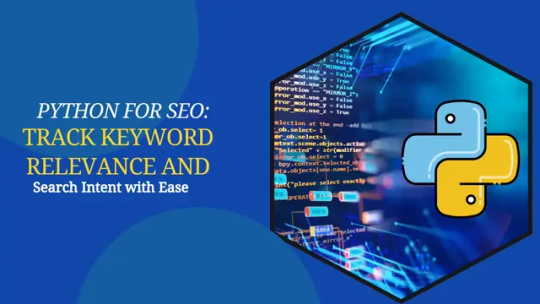
Python is no longer just a programming language for developers; it’s becoming an invaluable tool for SEO looking to sharpen their strategies. Imagine wielding the power of automation and data analysis to elevate your search engine optimization efforts. With Python, you can dive deep into keyword relevance and search intent, unraveling mysteries that traditional methods might overlook.
As the digital landscape evolves, so too must our approaches to SEO. Understanding what users want when they type a query into Google is crucial. The right keywords can make or break your online visibility. That’s where Python comes in—streamlining processes and providing insights that drive results.
Ready to unlock new possibilities? Let’s explore how Python can transform your SEO game by offering innovative ways to track keyword relevance and decode search intent with ease. Whether you’re a seasoned pro or just starting out, this journey promises valuable tools tailored for modern SEO challenges.
Understanding Keyword Relevance and Search Intent
Keyword relevance is the heart of effective SEO. It refers to how closely a keyword matches the content on your page. Choosing relevant keywords helps search engines understand what your site offers.
Search intent goes deeper. It’s about understanding why users perform a specific query. Are they looking for information, trying to make a purchase, or seeking navigation? Grasping this concept is crucial for creating content that resonates with audiences.
Different types of search intents exist: informational, transactional, navigational, and commercial investigation. Each type requires tailored strategies to meet user expectations effectively.
By aligning keyword relevance with search intent, you can craft content that not only attracts visitors but also engages them meaningfully. This dual focus enhances user experience and boosts rankings in SERPs over time.
Using Python for Keyword Research
Keyword research is a crucial step in any SEO strategy. Python simplifies this process significantly, allowing you to analyze large datasets efficiently.
With libraries like Pandas and NumPy, you can manipulate and clean keyword data quickly. These tools help you uncover valuable insights that drive content creation.
You can also use the Beautiful Soup library for web scraping. This enables you to gather keywords from competitor sites or industry forums effortlessly.
Additionally, integrating Google Trends API within your scripts offers real-time keyword popularity metrics. This feature helps identify rising trends that are relevant to your niche.
Python scripts automate repetitive tasks, freeing up time for more strategic initiatives. By leveraging these capabilities, you’re better equipped to optimize your campaigns effectively without getting bogged down by manual processes.
Tracking Search Intent with Python Scripts
Understanding search intent is crucial for any SEO strategy. With Python, you can automate the process of analyzing user queries and determining their underlying motivations.
Using libraries like BeautifulSoup or Scrapy, you can scrape SERPs to gather data on keyword rankings and associated content. This helps identify patterns in how users interact with different topics.
Additionally, Natural Language Processing (NLP) tools such as NLTK or spaCy can assist in categorizing keywords based on intent—whether informational, transactional, or navigational.
By implementing custom scripts, you can quickly assess which keywords align best with your audience’s needs. This not only saves time but also enhances your ability to target content effectively.
Automating this analysis allows for regular updates on changing search behaviors. Staying ahead of trends means better optimization strategies that resonate with real user intent.
Integrating Python into your SEO Workflow
Integrating Python into your SEO workflow can transform how you approach data analysis and keyword tracking. By automating repetitive tasks, you free up valuable time for strategic thinking and creative exploration.
Start by leveraging libraries like Pandas to analyze large datasets efficiently. This helps in identifying trends or anomalies that might be missed with traditional methods.
You can also use Beautiful Soup for web scraping, allowing you to gather competitor insights directly from their sites. Extracting relevant information becomes a breeze, enhancing your research capabilities.
Consider creating custom scripts tailored to your specific needs. Whether it’s monitoring rankings or analyzing backlinks, Python allows unprecedented flexibility.
Incorporate visualizations using Matplotlib or Seaborn to present data clearly. These visuals make it easier to share findings with team members or stakeholders who may not be as familiar with the technical aspects of SEO.
Tips and Tricks for Mastering Search Intent Analysis with Python
Mastering search intent analysis with Python can elevate your SEO strategy. Start by leveraging libraries like Pandas and Beautiful Soup for efficient data manipulation and web scraping.
Utilize Natural Language Processing (NLP) techniques to understand user queries better. Libraries such as NLTK or SpaCy can help you analyze keywords, phrases, and their contexts.
Make your code modular. Break down functions into smaller components for cleaner debugging and easier updates in the future.
Experiment with machine learning models to predict user behavior based on historical data. Tools like Scikit-learn offer a range of algorithms that can enhance your insights dramatically.
Stay updated with SEO trends. Adapt your scripts regularly to reflect changes in search engine algorithms and user preferences. Continuous learning is key in this ever-evolving field!
Conclusion
As the digital landscape continues to evolve, SEO professionals must adapt and innovate. Python has emerged as a powerful tool that can transform how you approach keyword relevance and search intent.
With Python, you can streamline your keyword research process, analyze massive datasets quickly, and effectively interpret user intent behind searches. The ability to automate repetitive tasks frees up time for deeper strategic thinking.
Integrating Python into your SEO workflow enhances efficiency and results in more targeted strategies. Real-world applications showcase its versatility—from scraping data from SERPs to analyzing trends over time.
By leveraging Python for SEO activities, you’re not only keeping pace with the industry but also setting yourself apart as a forward-thinking professional ready to tackle the challenges of tomorrow’s search engines. Embrace this technology; it could very well be your secret weapon in achieving online success.
0 notes
Text
AI + SEO: The Smartest Pair in 2025 Rankings

In 2025, AI for SEO isn’t just a trend—it’s the backbone of smart, scalable, and strategic digital growth. With Google becoming increasingly sophisticated, businesses must evolve beyond keyword stuffing and outdated practices. If you're still doing SEO manually, you’re already falling behind. Let’s explore how AI for SEO is transforming the landscape—and how you can ride the wave.
What Is AI for SEO?
AI for SEO refers to the use of artificial intelligence technologies—like machine learning, NLP (Natural Language Processing), and data analytics—to improve search engine optimization strategies. From content optimization to predictive analytics, AI helps brands make data-driven decisions that increase rankings and visibility.
Whether you're a solopreneur or working with a top-tier SEO agency in Delhi, AI ensures your SEO efforts are faster, more accurate, and far more effective.
How AI Is Changing SEO in 2025?
Here's how AI is changing SEO in 2025 and why it’s a game-changer:
Content Generation & Optimization: Tools like Jasper and Surfer SEO use AI to generate content outlines, suggest keywords, and evaluate on-page optimization—all tailored to Google’s latest algorithm updates.
Voice & Visual Search: AI enables SEO strategies to go beyond text. Voice and image recognition are critical in 2025, and optimizing for them requires tools that understand user intent and behavior.
Search Intent Prediction: AI can analyze patterns in search queries and help predict user intent more accurately, ensuring content ranks higher for the right audience.
Automated Technical SEO: Platforms like Screaming Frog and SEMrush have evolved with SEO automation tools that use AI to detect crawl issues, broken links, and even schema markup errors automatically.
Must-Have SEO Automation Tools in 2025
Here are three essential SEO automation tools you need this year:
MarketMuse: Uses AI to identify keyword gaps and create content briefs.
Clearscope: Provides real-time SEO grading and optimization recommendations.
Frase: Combines AI-driven SERP analysis with content creation capabilities.
These tools not only reduce your workload but also drastically increase content effectiveness by aligning with how AI for SEO is shaping search engine behaviors.
Why SEO Agencies in Delhi Are Doubling Down on AI?
As competition rises in India’s digital economy, every SEO agency in Delhi is turning to AI to offer better ROI and faster results. From hyperlocal targeting to multilingual content optimization, AI makes it easier to scale smartly. Businesses that leverage this shift with the right agency will dominate search rankings.
What is AI for SEO in 2025?
AI for SEO in 2025 refers to the use of artificial intelligence tools and algorithms to automate, enhance, and scale SEO strategies. It helps in analyzing data, predicting trends, optimizing content, and improving site performance for better search engine rankings.
Actionable Guide: How to Use AI for SEO in 2025
Step 1: Choose a reliable AI SEO tool like Surfer, Jasper, or Frase.
Step 2: Integrate it with your content management system.
Step 3: Use AI to identify trending topics, optimize meta data, and create structured content.
Step 4: Automate site audits monthly to catch technical issues early.
Step 5: Monitor performance via Google Search Console and adjust with AI-based recommendations.
By following these steps, your site won’t just rank—it will outperform.
Final Thoughts
The integration of AI for SEO is no longer optional. From automation to precision, AI is the digital marketer’s most powerful partner in 2025. To compete—and win—you must evolve with these tools. Partnering with experts who understand both SEO and AI is your first step toward smarter digital success.
Work with Delhi’s Leading AI-First SEO Agency
If you're serious about ranking in 2025, it’s time to ditch the guesswork. At iWrite India, we blend human creativity with AI precision to deliver SEO results that actually move the needle. From smart automation to content intelligence, we help businesses grow faster and rank better.
Top 5 Unique FAQs on AI for SEO
Q1. Can AI completely replace human SEO strategists? No, AI enhances human capabilities but doesn’t replace strategic thinking, creativity, or contextual understanding. Think of it as a powerful assistant.
Q2. Are AI SEO tools expensive? Some advanced tools have subscription costs, but many offer flexible pricing tiers. Plus, the ROI usually outweighs the expense by boosting traffic and conversions.
Q3. What are the biggest risks of using AI for SEO? Overreliance can lead to generic or over-optimized content. Always pair AI insights with editorial expertise to maintain authenticity and engagement.
Q4. Is AI good for local SEO in 2025? Absolutely. AI can analyze location-based search behavior, optimize for local queries, and improve listings for local pack visibility.
Q5. How can small businesses use AI for SEO affordably? Start with freemium tools like Ubersuggest or ChatGPT, then scale as your business grows. Many tools also offer small business plans with AI features.
#ai for seo#seo automation tools#how ai is changing seo#seo trends 2025#SEO Agency in Delhi#digital marketing in Delhi
0 notes
Text

The term automated SEO tools refers to the software applications that help SEO professionals automate their tasks and reduce the amount & effort of manual working. Basically, there are multiple SEO tools available on the web that help improve the health of your website and overall business growth.
Let’s look at the points below and learn how automated SEO tools are helpful for your website.
Automated SEO Tools help in doing backlink analysis.
Assist you in determining your website’s position by creating the SEO report, including online visibility, site traffic, strategy issues, and more. Consequently, let you know at which point of SEO you need to work more.
Allow you to monitor and resolve SEO issues and improve efficiency.
You can search the best-trending keyword with automated SEO tools and can track the rank of your keyword as well as your website.
0 notes
Text
6 Powerful YouTube Tools — Free & Online
Speed up your YouTube workflow with these must-have tools by Thumbnail Downloader. No login required, 100% browser-based!
YouTube Thumbnail Downloader – Instantly preview and save thumbnails in HD.
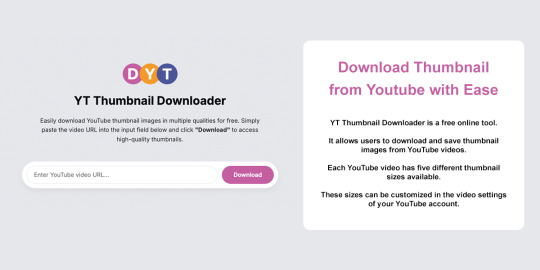
2. Profile Picture Downloader – Get any channel’s profile photo in full resolution.
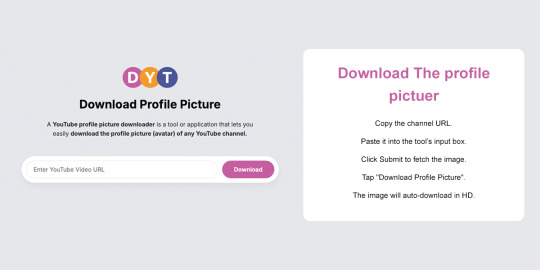
3. Channel Banner Downloader – View and download channel art in one click.
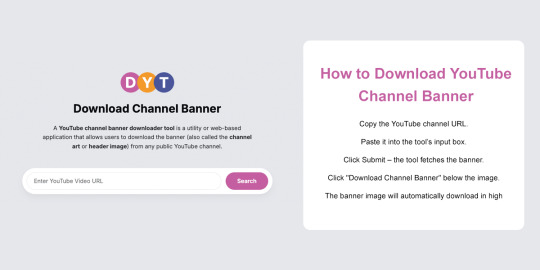
4. YouTube Video Trimmer – Trim and cut YouTube videos online without downloading.
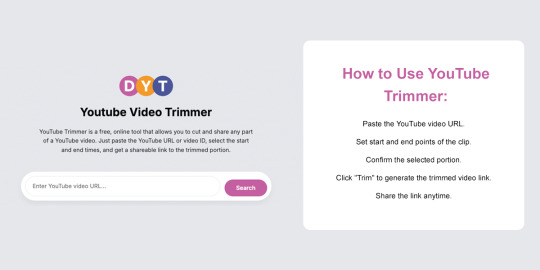
5. Transcript Viewer – Extract subtitles and closed captions from any video.
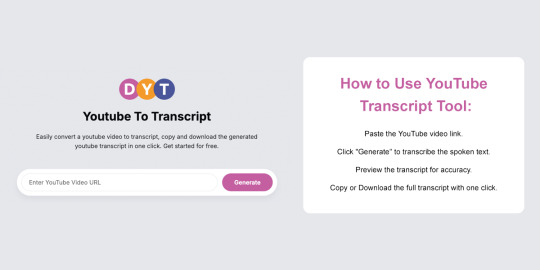
6. YouTube Comment Picker – Run giveaways or pick random winners easily.
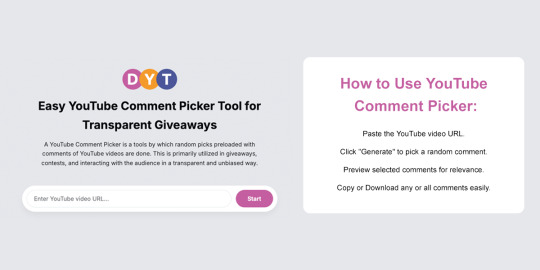
#youtube tools#creator tools#youtube thumbnail#comment picker#downloader#video trimmer#2025 tools#youtube SEO#free online tools#tech tools#ai tools 2025#productivity tools#content tools#seo tools#video tools#best free tools#ai for youtube#automation tools
4 notes
·
View notes
Text
Difference Between Manually Humanizing AI Text vs Using an AI To Human Text Converter
AI-generated content has become increasingly prevalent. Whether for academic writing, blog posts, or content marketing, AI-generated text can serve as a quick starting point for various writing tasks. However, there’s a clear distinction between manually humanizing AI text and using a reliable AI to human text converter. AI To Human Text Converter offers an efficient, free tool to convert AI-generated text into human-like content without compromising meaning, making it a must-have resource for content creators, students, and professionals.
What is AI to Human Text Conversion?
AI to human text conversion refers to transforming machine-generated content into natural, human-readable text. AI-generated text is often monotonous, lacks engagement, and reads robotically, making it necessary to humanize it for professional use.
When it comes to humanizing AI text, there are two approaches:
Manual Humanization: Manually refining the content by rewriting it, adjusting tone, and improving readability.
Using an AI To Human Text Converter: Automating the process with a specialized tool that instantly converts AI-generated text into a more natural-sounding format.
Let’s explore the differences between these two methods.
Manual Humanization of AI Text
Manually humanizing AI text can be effective but comes with its own set of challenges.
Speed: Manually editing and rewriting AI-generated content is time-consuming. It requires a keen understanding of tone, context, and structure to make the text flow naturally.
Complexity: Manually humanizing text demands a high level of effort and expertise. You need to rephrase sentences, break down robotic language, and ensure that the text makes sense while retaining its original meaning.
Security Risks: When manually humanizing AI text, especially if it's sensitive content, the risk of human error increases. There’s always a chance that important details could be misrepresented or misunderstood.
Limitations: Manually refining large volumes of AI-generated text is often overwhelming. This method is not ideal for those who need to process substantial content within tight deadlines.
Using an AI To Human Text Converter
Conversely, an AI To Human Text Converter automates the entire process and offers several benefits over manual humanization.
Speed: Converting AI-generated text into human-readable content is nearly instantaneous with a tool like AI To Human Text Converter. Instead of spending hours manually editing content, users can generate human-like text in seconds.
Simplicity: The tool’s user interface is straightforward, requiring no prior knowledge or expertise to use effectively. Just paste the AI-generated text, click convert, and you’re done!
Security: Since the conversion happens without the need for third-party apps or plugins, security risks are minimized. The tool allows users to safely convert any content while ensuring confidentiality.
No Limitations: With AI To Human Text Converter, there are no usage limits. You can convert as much AI text as needed without worrying about word counts, logins, or subscription fees.
Completely Free: Unlike many online tools that charge for premium access or impose restrictions on free versions, AI To Human Text Converter is entirely free with unlimited usage. No login, signup, or subscription is required.
Key Features Comparison
FeaturesManual Humanize AI TextAI To Human Text ConverterConversion of AI-Generated ContentAvailableAvailableUser InterfaceNot ApplicableStraightforwardSpeedSlowerExtremely FastSecurity RiskRisk-proneSecureUsage LimitationsLimitedUnlimited
Why Use AI To Human Text Converter?
If you’re tired of spending hours trying to manually humanize AI-generated content or need a quick, efficient way to transform robotic text into something engaging and natural, AI To Human Text Converter is the perfect solution. Here’s why it’s the best choice for you:
Free of Cost: The tool is 100% free with no hidden charges. Convert as much text as you need without worrying about subscriptions or limits.
No Authentication Required: There’s no need to sign up or log in. The tool is ready for immediate use.
Unlimited Usage: Whether you’re working on a single article or hundreds of pages, AI To Human Text Converter allows you to convert unlimited content.
Quick and Accurate: Get your AI-generated content humanized in seconds, with natural flow and readability.
Ideal for Multiple Applications: Whether it’s for assignments, essays, marketing materials, or blog posts, this tool ensures your text is suitable for any professional setting.
Why Manual Humanization is Not Always Practical
While manually humanizing AI-generated text can yield good results, it’s often impractical. Here’s why:
Time-Consuming: If you have large volumes of text, manually refining it will take too long. For students or professionals working on tight deadlines, this isn’t a viable solution.
Inconsistency: Manually humanizing content introduces the risk of inconsistencies. What may seem like a minor adjustment to one part of the text might lead to inconsistencies in tone or style.
Increased Effort: Editing AI content manually requires considerable effort, especially for non-professionals who may struggle with rewriting sections effectively.
Choosing between manually humanizing AI text and using an AI to human text converter depends on your needs, time constraints, and the volume of content you’re working with. For anyone looking to save time and effort, AI To Human Text Converter is an invaluable tool. It simplifies the process, delivers human-like text instantly, and comes with no cost or limitations.
Try AI To Human Text Converter today, and discover how easy it is to humanize AI-generated text with just a few clicks!
#AI to human text#AI to human text converter#AI-generated content#humanize AI text#convert AI-generated text#free AI to human text converter#AI content refinement#manually humanizing AI text#human-readable text#AI to human text bypass#AI text tool#unlimited AI text conversion#AI text conversion for assignments#AI text conversion for essays#convert AI text for free#human-like text#AI text to human-readable content#free tool for AI to human text conversion#improve AI content readability#AI text to human content SEO#transform AI-generated content#automate AI text humanization#manual vs automated AI text conversion#secure AI text conversion tool#AI text conversion without login#fast AI text conversion tool#no limitation AI text conversion tool
4 notes
·
View notes
Text
SEO Automation: Tools and Techniques for 2024
In 2024, SEO automation has become crucial for businesses aiming to enhance their digital marketing efficiency. Automating repetitive tasks such as keyword research, content optimization, and performance tracking helps save time and reduces human error, allowing marketers to focus on strategic activities.
Top Tools for SEO Automation At the forefront of SEO automation are several potent technologies. Ahrefs and SEMrush excel in keyword research and competitive analysis. Relevance and readability are enhanced by Surfer SEO and Clearscope, while technical SEO audits are automatically conducted by Screaming Frog and Botify to find and address problems that impact search engine rankings.
Effective Automation Techniques
To maximize SEO automation, begin with comprehensive keyword research using automation tools to track performance and adjust strategies as needed. Utilize AI-driven platforms to generate content outlines and optimize metadata. Automate link-building by identifying high-authority sites and managing outreach efforts efficiently.
Balancing Automation with Human Insight
While automation handles data-driven tasks, human insight remains essential for creativity and strategy. Ensure your team reviews and refines automated outputs to maintain authenticity and effectiveness in content and link-building campaigns.
Future of SEO Automation
Advancements in AI and machine learning will further enhance SEO automation capabilities, predicting search trends and personalizing user experiences. Staying updated with these technologies is essential for maintaining a competitive edge.
Challenges and Considerations in SEO Automation
Despite its numerous benefits, SEO automation comes with its own set of challenges. Over-reliance on automation can lead to generic content that lacks the unique voice and personal touch crucial for engaging audiences. It is essential to strike a balance where automation aids but does not replace human input. Additionally, staying compliant with search engine guidelines is vital to avoid penalties associated with automated practices.
The Role of Data in SEO Automation
Data plays a pivotal role in the success of SEO automation. Real-time analytics and insights can guide automated processes, ensuring they are aligned with the latest trends and audience behaviors. Tools that offer robust data analysis capabilities can help businesses make informed decisions, refining their strategies for better outcomes.
In conclusion, SEO automation is essential for businesses in 2024, enhancing efficiency and allowing marketers to focus on strategy and creativity. By combining automated tools with human insight, companies can create authentic, engaging content and stay competitive. As AI and machine learning evolve, embracing SEO automation will drive organic growth and improve search engine visibility, ensuring long-term success in a dynamic digital View.
2 notes
·
View notes
Text
Essential Inbound Marketing Tools for 2024

In the fast-paced world of digital marketing, staying ahead of the curve is crucial. Inbound marketing is all about attracting, engaging, and delighting customers. To do this successfully, you need the right tools.
In 2024, there are important inbound marketing tools available. These tools can help make processes easier, improve content creation, and enhance marketing strategies. If you work in inbound marketing, content creation, or brand strategy, these tools can help you improve your work.
1. CMS Hub Professional
One of the cornerstones of any successful inbound marketing strategy is a robust content management system (CMS). CMS Hub Professional by HubSpot offers a comprehensive solution that integrates seamlessly with other marketing tools. It allows marketers to create, optimize, and analyze their website content efficiently.
Key Features:
Custom Themes: Easily create a visually appealing and functional website without needing extensive coding knowledge.
SEO Recommendations: Built-in SEO tools provide actionable recommendations to improve search engine rankings.
Adaptive Testing: Conduct A/B testing to determine the most effective content and design elements.
Advanced Analytics: Gain insights into user behavior and content performance to make data-driven decisions.
2. Operations Hub Starter
As your marketing operations grow, maintaining data integrity and streamlining workflows become paramount. Operations Hub Starter helps automate and expand marketing efforts by connecting and organizing data from various platforms.
Key Features:
Data Sync: Sync data across various applications to ensure consistency and accuracy.
Automated Workflows: Create workflows to automate repetitive tasks, saving time and reducing errors.
Custom Properties: Tailor data properties to fit your specific business needs.
3. HubSpot Free vs Paid
When considering HubSpot, understanding the differences between HubSpot Free vs Paid plans is crucial. The free version offers essential tools to help you begin. The paid versions offer more advanced features. These features can enhance your marketing efforts.
HubSpot Free:
Email Marketing: Basic email marketing tools with limited customization options.
Forms: Create forms to capture leads and integrate them with your CRM.
Ad Management: Manage ad campaigns and track performance.
HubSpot Paid:
Advanced Analytics: In-depth analytics and reporting tools to measure the effectiveness of your campaigns.
Marketing Automation: Advanced automation features to nurture leads and convert them into customers.
Content Creation Tools: Enhanced tools for creating and managing content across various platforms.
4. HubSpot Website Grader
For businesses looking to evaluate and improve their website performance, the HubSpot Website Grader is an invaluable tool. This free tool analyzes your website and provides a detailed report on its strengths and weaknesses.
Key Metrics Evaluated:
Performance: Assess how quickly your website loads and identify areas for improvement.
Make sure to optimize your site for mobile devices to improve mobile friendliness.
SEO: Evaluate your site's SEO and get recommendations to enhance visibility.
Security: Check for potential security burden and get tips to protect your site.
5. Choosing the Right Inbound Marketing Agency
Partnering with an inbound marketing agency can significantly amplify your marketing efforts. These agencies work on creating strategies to attract more visitors, generate new leads, and convert potential customers into buyers.
Benefits of Working with an Inbound Marketing Agency:
Expertise: Leverage the expertise of professionals who stay updated with the latest marketing trends and technologies.
Efficiency: Save time and resources by outsourcing complex marketing tasks.
Customized Strategies: Get tailored strategies that align with your business goals and target audience.
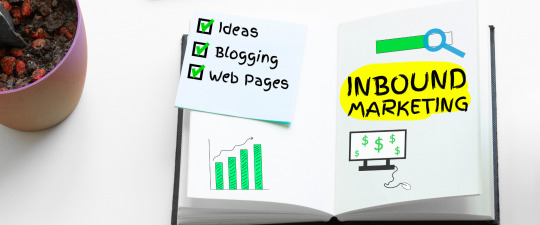
6. Local Marketing Support: Online Marketing Company Near Me
Finding an online marketing company near me can offer the advantage of local market insights and personalized support. Local agencies understand the unique challenges and opportunities in your area, providing more relevant and effective marketing solutions.
7. Content Creation Agency
Content is king in inbound marketing. A content creation agency can help you develop high-quality, engaging content that resonates with your audience. Agencies can create different types of content like blog posts, articles, videos, and infographics with their expertise.
Services Offered by Content Creation Agencies:
Content Strategy: Develop a comprehensive content strategy that aligns with your business goals.
Content Production: Create a wide range of content formats tailored to your audience.
Content Optimization: Optimize content for search engines and user engagement.
8. Brand Strategy Firms
Establishing a strong brand identity is essential for standing out in a crowded market. Brand strategy firms specialize in developing and refining your brand's image, voice, and messaging to ensure consistency and impact.
Key Services:
Brand Positioning: Define your brand's unique value proposition and market positioning.
Visual Identity: Create cohesive visual elements, including logos, color schemes, and typography.
Messaging: Develop clear and compelling messaging that resonates with your target audience.
9. Inbound Marketing Tools
In addition to the tools mentioned above, several other inbound marketing tools can enhance your strategy. These tools help automate processes, analyze data, and improve engagement with your audience.
Popular Inbound Marketing Tools:
SEMrush: Comprehensive SEO and competitive analyzing tool.
Mailchimp: Email marketing platform with robust automation features.
Hootsuite: Social media management tool for scheduling and analyzing posts.
Google Analytics: In-depth web analytics to track and understand user behavior.
10. Ad Agencies in Cincinnati
Businesses in Cincinnati can benefit from working with local ad agencies for specialized advertising solutions. These agencies provide various services, including both traditional advertising and digital marketing, to help you effectively reach your target audience.
Services Provided by Ad Agencies:
Campaign Development: Create and execute multi-channel advertising campaigns.
Media Buying: Purchase and manage ad placements across various platforms.
Creative Services: Develop compelling ad creatives that capture attention and drive action.
Conclusion
As we venture into 2024, leveraging the right inbound marketing tools is more important than ever. If you are using CMS Hub Professional for your website, Operations Hub Starter can automate processes. Additionally, comparing HubSpot Free vs Paid can help improve your marketing efforts.
These tools have the potential to greatly enhance your marketing strategies.
Partnering with an inbound marketing agency, content creation agency, or brand strategy firms can further amplify your strategy. If you need marketing assistance, consider hiring a local online marketing company or advertising agency in Cincinnati for help. They can provide customized solutions to meet your needs.
Use these tools and partnerships in your marketing plan. They will help you attract, engage, and please your audience. This will lead to growth and success in 2024 and beyond.
#hubspot cms#hubspot agency#hubspot automation#hubspot#inbound marketing#inbound marketing tools#digitalmarketing#SEO#content creation agency#hubspot free vs paid#sales hub#hubspot starter#cms hub professional
3 notes
·
View notes
Text
#Digital marketing tools#Startup marketing tools#Digital marketing India#Tools for new startups#SEO tools for startups#Marketing automation 2025#Content marketing tools#Free marketing tools#Growth tools for entrepreneurs#Small business digital marketing
0 notes
Text
TinyBull SEO Marketing for Small Business: Build a Strong Online Presence
TinyBull specializes in SEO marketing for small business to help you build a powerful online presence and attract more local customers. In today’s digital-first world, small businesses must compete not only with local competitors but also with larger brands. That’s where TinyBull steps in. Our tailored SEO services focus on ranking your business higher in search engine results, increasing organic traffic, and converting visitors into loyal customers. We begin with a detailed website audit, identify target keywords, and implement on-page and off-page strategies. We also provide local SEO, including Google Business Profile optimization, citation building, and mobile SEO to enhance your local search performance. With transparent monthly reports and data-driven decisions, TinyBull ensures you're always in control of your marketing strategy. Whether you're just starting or looking to scale, TinyBull SEO marketing for small business is your trusted path to long-term digital success.
#seo marketing for small business#seo services for small business#Local SEO Services#Local SEO services usa#Social Media scheduler#Social Media scheduling tool#Social Media Marketing Cloud#social Media Automation Platform#email marketing campaign strategy#smm plans for business#video production for business#commercial video production#video production company#social media marketing services#search engine marketing firms
0 notes
Text
#ai writing tool#ai tool for content writing#ai automation tools#seo automation#seo autopilot#ai automation#ai for seo#seo writing ai#ai for blog writing#ai content writer#ai content writing tool
0 notes
Text
Unlocking the Power of Copybot AI: The Ultimate Guide to Automated Content Creation
In the digital era, content is king—but creating high-quality, engaging, and optimized content consistently is a challenge for businesses, marketers, and creators. Enter Copybot AI, a revolutionary tool designed to automate the content creation process, making it faster, easier, and more effective for users of all backgrounds. This comprehensive guide will walk you through what Copybot AI is, how…
#AI content generation#AI writing assistant#automated copywriting#content automation#Copybot AI tutorial#digital marketing tools#Passive Income#SEO tools
0 notes
Text
Everything you Need to Know About SEO Automation
SEO automation is the process of automating SEO tasks that are repetitive and monotonous. The SEO tasks include managing meta tags, optimizing images, tracking analytics, tracking fluctuations in search engine rankings, and generating reports.
The processes of SEO automation are
Keyword Research-
With SEO automation you can quickly identify keywords relevant to your target audience. This will result in high-value traffic opportunities.
Content Creation-
You can generate high-quality blog posts and website content with AI-driven writing services. This ensures that you have put enough keywords throughout your writing. An automated SEO software called SurferSEO provides suggestions for your writing.
Technical Optimization-
You can save time on page speed optimization and technical audits and avoid all mistakes. This can be done by automated checks. SEO audit tools crawl your website and generate reports on issues found.
Reporting and Analytics-
You can SEO performance and automatically generate reports with analytics tools such as Google Analytics, Google Data Studio, etc. You can get instant insights into the amount of traffic you are getting, which content is performing the best, where your visitors are coming from, etc.
Automated rank tracking-
You can monitor how to rank for target keywords in the search engine results pages (SERPs). You can track competition and fluctuations in the SERPs. You will even get notifications when a competitor’s content ranks higher than yours.
Automated Image Optimization
With SEO automation you can automatically optimize images for SEO. This will improve your page loading times without losing image quality.
0 notes
Text
Discover 25 AI side hustles that really work and require zero budget. Use AI tools to create, manage, and grow your income streams easily! 💼🚀 #MakeMoneyOnline #MakeMoneyWithAI #SideHustle #SideHustleWithAI
#AI automation services#AI blog monetization#AI blog monetization strategies#AI blog SEO#AI blogging platforms#AI blogging platforms 2025#AI blogging tips#AI blogging tips 2025#AI blogging tips and tricks#AI budget management#AI budgeting apps#AI budgeting apps 2025#AI budgeting apps for freelancers#AI budgeting for entrepreneurs#AI budgeting help#AI budgeting software#AI budgeting tips#AI budgeting tools#AI budgeting tools 2025#AI business ideas#AI caption generation#AI caption writing#AI caption writing tools#AI chatbot business#AI chatbot development#AI chatbot development tools#AI chatbot marketing#AI chatbot marketing 2025#AI chatbot marketing strategies#AI chatbot platforms
0 notes
Text
Money Robot Submitter Software – Powerful SEO Link Submission Tool
Get high-quality backlinks fast with Money Robot Submitter. Automate your SEO campaigns and improve your website’s authority and traffic.

Unlock the gateway to unparalleled online visibility with Money Robot Submission Software, the pinnacle of SEO link submission mastery. Designed for ambitious marketers and SEO professionals, this Robot tool promises to catapult your website to the top of search engine rankings. Experience seamless integration of smart technology and unmatched user-friendliness, making it the top choice amidst a sea of competitors. Harness the power of sophisticated algorithms that simulate human behavior to create a genuine backlink network, driving organic traffic to your digital doorstep. Achieve exponential growth with precision targeted submission, ensuring your content shines like a beacon in the vast digital arena. Embrace the future of SEO with Money Robot Submission Software—where innovation meets excellence, and success is just a click away. Turn your digital aspirations into reality and invest in a tool that is a testament to technical excellence and unmatched efficiency.
#makemoney#Money Robot Submitter#link submission#SEO backlinks#automated SEO software#link building tool#SEO marketing
1 note
·
View note
Text
I Tested Every Major AI Tool for 6 Months - Here's What Actually Works
Twelve months ago, I was drowning in work. Like most business owners, I was wearing too many hats, juggling too many clients, and feeling like I was always one step behind. That’s when I decided to dive headfirst into the AI revolution everyone was talking about. But here’s the thing – I didn’t want to just dabble. I wanted to really understand what these tools could do for someone like me. So I…
#AI automation tools small business#AI productivity tools save time money#AI SEO tools 2025 comparison#AI task agents for business automation#AI tools content creation business#AI tools for business 2025#AI tools productivity increase ROI#AI workflow automation real results#best AI productivity tools#business AI tools that actually work#ChatGPT Claude Gemini Deepseek review#ChatGPT vs Claude comparison#I tested AI tools for 6 months results#small business AI automation tools
0 notes